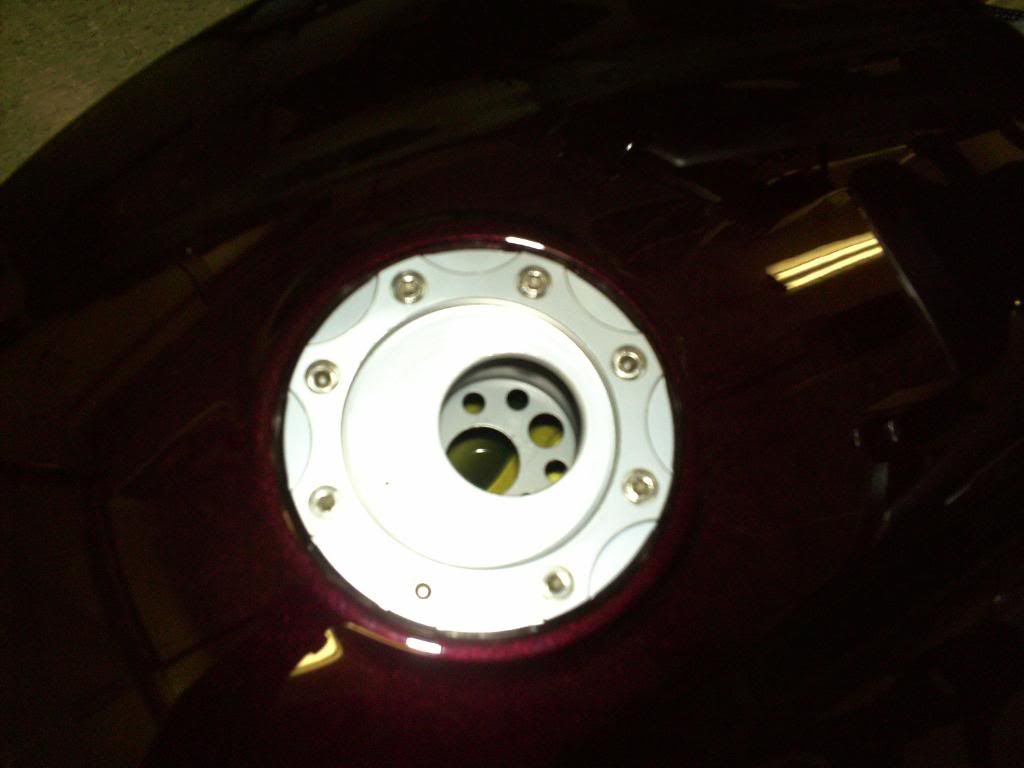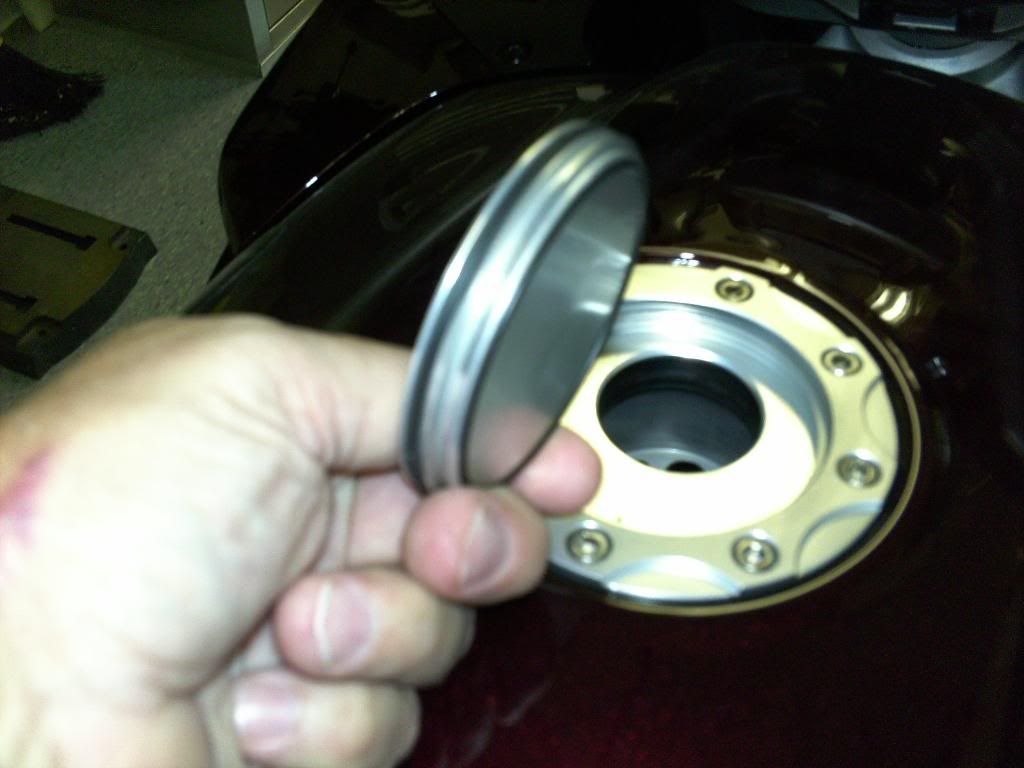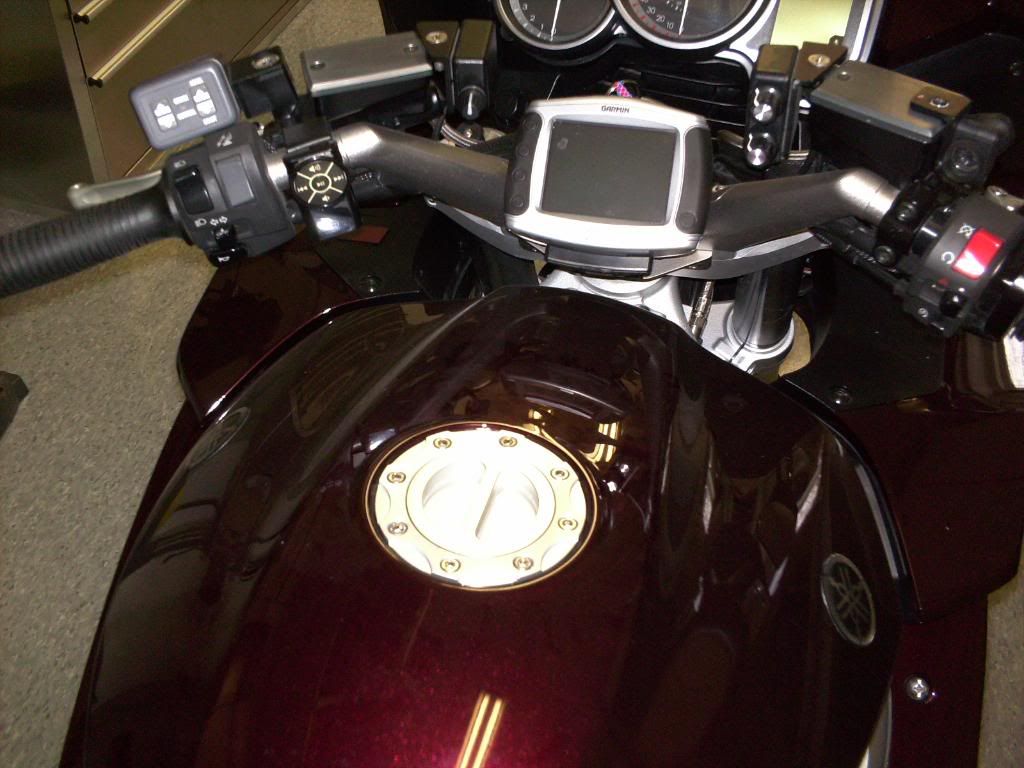Joe2Lmaker
Well-known member
I'm going to try to take some more photos for you guys later today.
:good:

I'm going to try to take some more photos for you guys later today.
Thanks LP!LP,
Your cap looks like a very nice setup. Does yours have a separate large billet washer under it? As it looks slightly different than the one on the website.
WW
Hey WW,
I think it's just the way the pictures are, because it's basically just the cap and the one piece base.
The only other thing the kit comes with is the cap screws, 3 long ones to attach to the tank and 5 short ones that are in the base for show.
I'm going to try to take some more photos for you guys later today.





How does the tank vent with that cap?
In the stock set-up there is a check valve affair built into the cap which provides a pressure relief path from the tank to the vent line at the (infamous) orange rubber grommet. Perhaps more important than the pressure relief is the fact that in the other direction it allows vacuum relief. Is the tank open underneath the new plate that the cap screws into, to the vent line where the orange grommet would be on the stock cap?
How does the tank vent with that cap?
In the stock set-up there is a check valve affair built into the cap which provides a pressure relief path from the tank to the vent line at the (infamous) orange rubber grommet. Perhaps more important than the pressure relief is the fact that in the other direction it allows vacuum relief. Is the tank open underneath the new plate that the cap screws into, to the vent line where the orange grommet would be on the stock cap?
In the picture with the cap off looking down, what the picture doesn't show is a very small vent hole, about 1/16" diameter. As I said earlier there has been no issue in the engine operation even with various fuel levels and large elevation changes. In my opinion the stock cap is overly complex or it is required that way to meet some pointless EPA mandate for gas caps. Even when removing the cap there is never any hissing or sound of air movement so there must be some other way that the tank is vented. I suspect it is through the hose that comes off the bottom of the tank near the rear?










Thanks for the detailed pictures, Spectre. It looks like your cap vents through those two small holes to the left side of the picture below, then under that plate to the open vent line and drain lines of the tank. What's up with the two holes though? It looks like (at least) one of them has some sort of a brass fitting pressed into it? Actually, since there is no seal between the base of that plate and the top of the tank could it possibly vent all the way around the outside? And what keep fuel from taking that same path?I just changed out the gas cap for a nice unit for sale on eBay for about $50 shipped. It was listed for the R1 and other Yamahas. Here is a picture of the finished product in place. The fit and finish are excellent. the gas cap has an O-ring around the edge, and the filler neck has a rubber gasket that mates to the tank. There is a vent system in the base.
More detailed photos of the cap and installation here:
Gas Cap web shots

From what I can tell, that little brass fitting is a check valve vent. I think the original breathes through that red rubber seal. With the replacement, the tank just breathes through the open space under the cap base. It appears the tank vent is to the left of the filler neck at 9 o'clock, and the drain is behind it at 6 o'clock. I might have them backwards, but the important thing it that air can enter and escape the tank. The replacement is probably more susceptible to water entry, but not much.
What I'm really interested in knowing is if the vent holes are just always open to atmosphere through the vent lines. I'm interested in knowing that as I'm considering modifying the internals of the stock cap to get rid of the pressure/check valve, since that has been suspected of cause gas geysers and tank implosions.
*************************************************************A little too blingy for me - and it would snag on my tank bagIf'n ya wanna git real radical, why not go for this one? All ya gotta do is look down, and you can see if'n ya got petrol in da tank. :blink:

CLICKY
I ordered the same one. Thanks, Specter, for doing the research and tracking this down. You just helped me eliminate one step in my rally gas stop procedure. :yahoo:I just changed out the gas cap for a nice unit for sale on eBay for about $50 shipped. It was listed for the R1 and other Yamahas.
(snip photos)




Fred, it *seems* these folks have done their homework on the venting. It is the same design for Ducati, MV Agusta and Yamaha.RJ,
Can you show some additional pics of the bottom of that cap, how it seals to the tank and how it vents? I'm a bit concerned since the stock cap vents the tank through the cap itself, and that one seems to be a solid billet of alloy.


There is a gasket that fits between the fill-neck and the new base -it keeps fuel where it needs to be.Looks good. So how about underneath the base piece? I assume that the vent hole just open to both the vent and overflow vent lines below? If so, I don't foresee any venting problems.
Enter your email address to join: